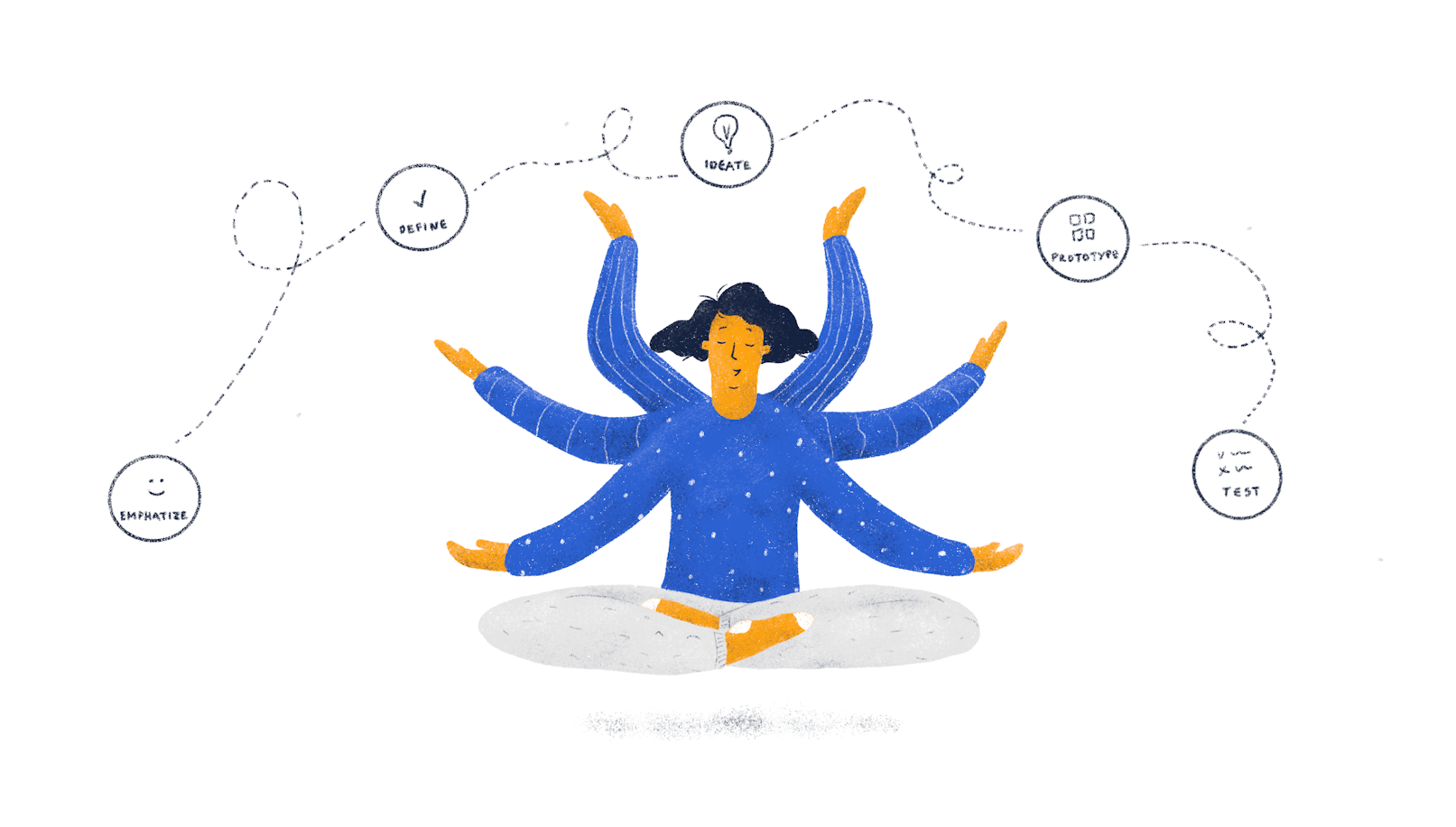Fundamentally, the Enteprise Design Thinking framework is a powerful tool that allows teams and companies to solve complex problems, all while focusing on innovation. In its standard form, this framework consists of five phases that are built around the user.
The foundations for the Design Thinking framework were laid back in the 1960s with the earliest attempts to view design through a more rigid and scientific lens. This process continued up to 1987 when Peter Rowe, who was Director of Urban Design Programs at Harvard, published his book Design Thinking. Rowe’s work served as a critical starting point for the framework we all know and use.
There have been multiple attempts to optimize Design Thinking over the years. After all, the business ecosystem continues to shift and change at an accelerating rate—old concepts take new shapes and pave the way for future change. One of such iterations of the framework is Enterprise Design Thinking (EDT), which emerged in the early 2010s at IBM.
EDT builds on the principles that are near and dear to its predecessor, but it manages to boost innovation while minimizing uncertainty and exposure to risk for larger organizations.
Revisiting the Original Design Thinking
Before we dive into the intricacies of Enterprise Design Thinking, let’s take a closer look at the original that it was built upon, namely its five phases. As you’ll see, every step of the framework is tightly connected to the steps that precede and follow it, creating a sense of coherence and cohesion in the design process and instilling a sense of logic into it.
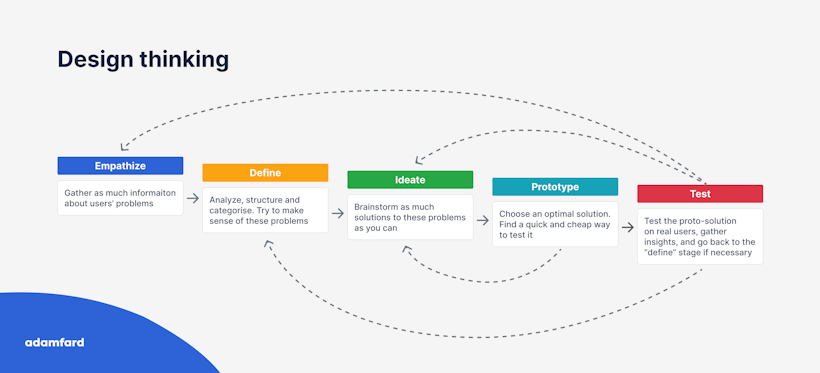
Empathize
The process starts with understanding the people you’ll be designing for. The goal is to acquire an empathetic understanding of the users, the context in which they’ll be using the product, and the problems they’d like to address via the product you’re creating. This is a critical component of human-centric design since it lets you discard assumptions from your decision-making process by extracting actionable insights about your users.

User interviews are one of the ways you could gather information about your users' pain points.
Define
The Define phase is where we process and synthesize the information that we gather during the Empathize stage. The main goal here is to define the core problem you’ll be addressing via design.

Putting your insights onto a whiteboard and then collaboratively sorting them is a good way to make sense of your findings.
Ideate
Once you’ve defined the problem, it’s time to seek solutions. The ideation phase is where your team brainstorms to identify viable and outside-the-box solutions to the above-mentioned problems.
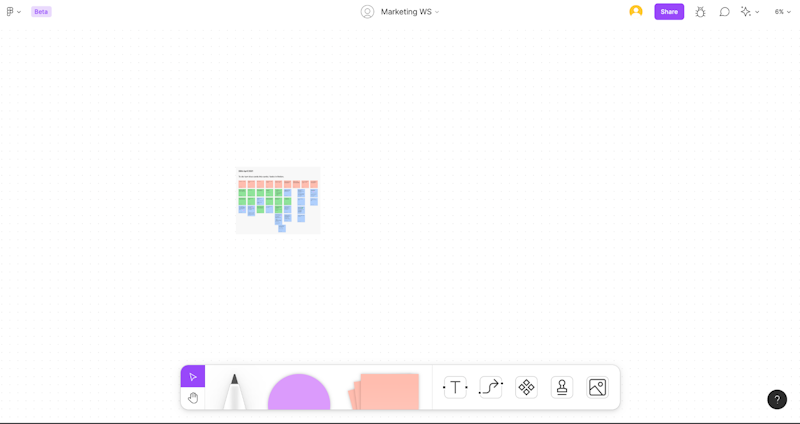
In a remote environment, whiteboarding tools help you brainstorm with your team in real-time.
Prototype
Prototyping is all about experimenting with the best solutions you’ve come across in the previous stage. Your goal here is to create a series of inexpensive and scaled-down low-fidelity wireframes of these solutions to explore whether they satisfy the users’ needs and whether they’re technically and financially viable.
Here's an example of an Interactive Prototype created in Figma. Go ahead and click around 😄
Test
Once the above solutions are developed, it’s time to test them. This is where the iterative nature of Design Thinking kicks in. The feedback that a team will collect during the Test stage will fuel further defining, ideation, and prototyping, which will allow the surfacing of better solutions.

Usability testing is one of the most potent ways to gauge early user feedback.
Applying Design Thinking to product design
We’ve mentioned above that there were several attempts to adapt and adjust Design Thinking to fit the needs of different teams and organizations. We want to mention a few of them—specifically, Double Diamond, Google Design Sprints, and the IDEO Design thinking program. Let’s take a quick look at their approaches.
Double Diamond
As the name of the framework suggests, there are two key areas in the process marked by diamonds. Within the first diamond, designers aim to focus on the problem a user is facing and learn as much actionable information about the context in which this problem arises. This is followed by defining the problem and identifying potential solutions for it.
The second diamond predominantly focuses on creating actual designs. Towards the end of the diamond, designers conduct multiple rounds of testing to identify the most viable solution.
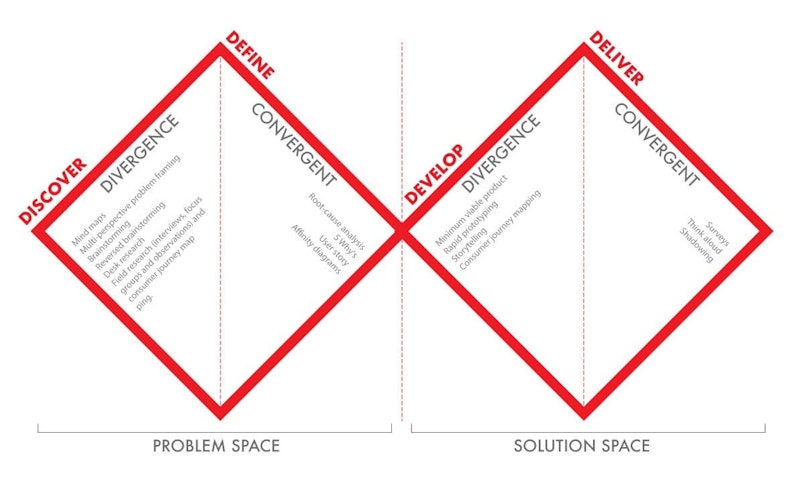
Google Design Sprint
This is a 5-day framework developed by Google Ventures by taking inspiration from Design Thinking. It has six central phases: Understand, Define, Sketch, Decide, Prototype, and Validate.
On Monday, the aim is to extract as much information about the project’s business goals, the end-users’ needs, and other key aspects that will allow informing further stages of design and development.
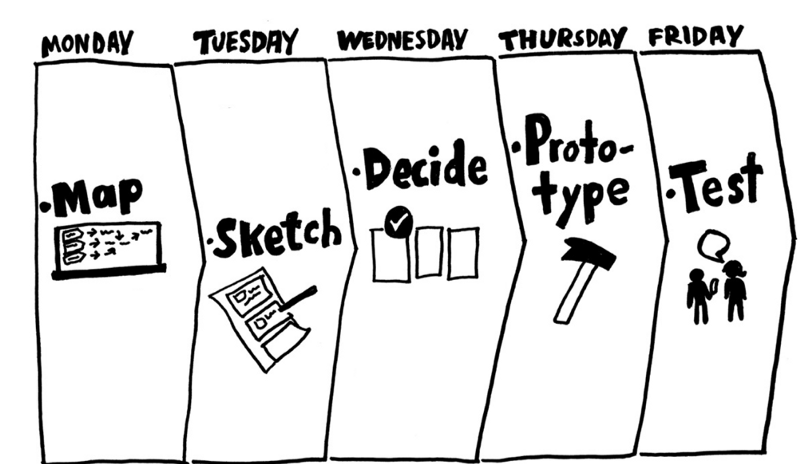
On Tuesday, the team should explore a wide array of possible solutions to the problems they’ve outlined the day before.
The main goal of day three is identifying the best idea and storyboarding it.
Thursday is dedicated to prototyping building something “quick and dirty” by focusing more on usability and less on looks.
Friday is all about putting the design in front of real users and identifying the potential flaws in your current design/solution.
IDEO Design Thinking
IDEO is one of the most reputable and innovative design firms out there. Their passion for human-centered design has led them to adapt the Design Thinking framework to suit their way of working and solving problems.
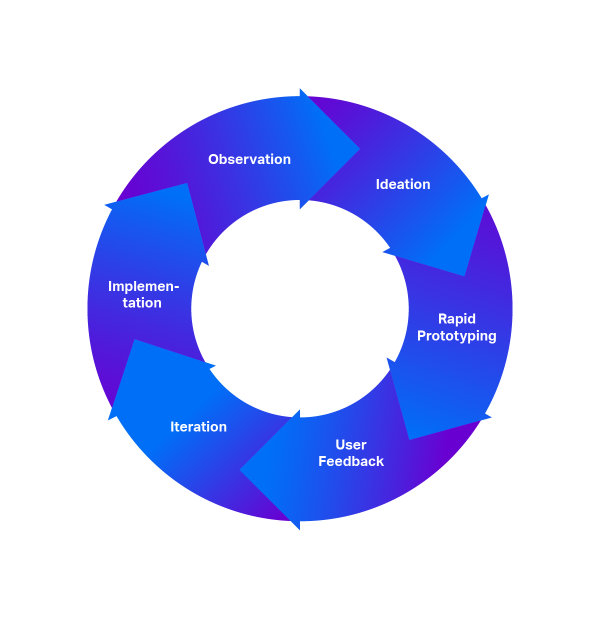
IDEO’s design process is divided into six stages:
Observation
Ideation
Rapid prototyping
User feedback
Iteration
Implementation
What is Enterprise Design Thinking?
Enterprise Design Thinking was originally developed by IBM back in the early 2010s. This framework aimed to adapt the agility and innovation that comes with Design Thinking to enterprise realities. Today, this model is used by a wide array of organizations around the world, throughout a wide array of industries and sectors.
Principles of Enterprise Design Thinking
We mentioned above that EDT is fundamentally rooted in traditional Design Thinking. However, there are some specific things that this framework focuses on to make it more valuable for enterprises.

Focusing on user outcomes
It is considered common practice to use the “5 Why’s” technique as part of EDT because one of the critical aspects of this framework is to understand the root causes of problems and understand how certain actions impact user outcomes.
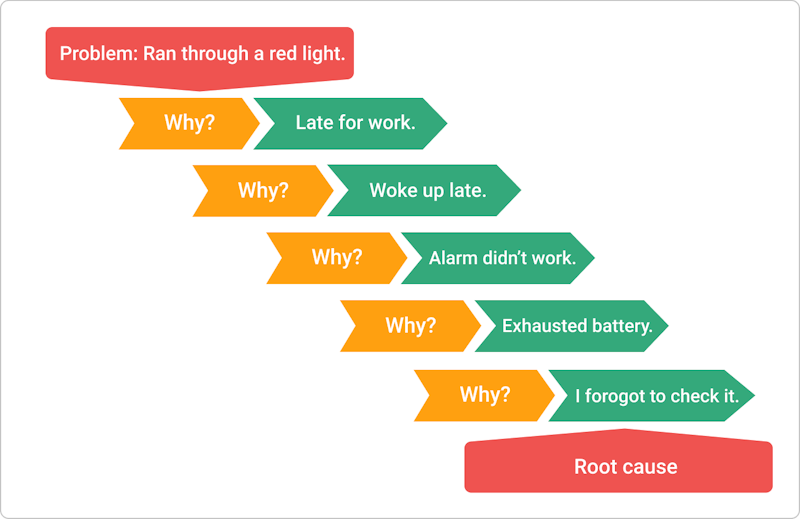
It’s also important to mention that it would be complicated to understand user outcomes without a well-defined user persona since it provides a wealth of insight into their problems and how their experiences can be improved.
Restless reinvention
A core tenet of EDT revolves around the continuous reinvention and improvement of products and experiences. The products we use today are starting grounds for future breakthroughs. Constantly searching for solutions and improvements is a cost-effective and risk-free path toward innovation.
Diverse and empowered teams
The people involved in the development of a product play a vital role in the process, yet an often-overlooked factor is the diversity of their skill sets and backgrounds. A culturally and professionally diverse team is a valuable asset for creativity and innovation.
The “keys”
Keys are a central component of EDT—they allow organizations to transform mere ideas into well-thought-out solutions while also ensuring cross-departmental alignment within the organization. IBM’s model features three keys: hills, playbacks, and sponsor users.
Hills
Hills, in EDT, is a term that helps teams align around user outcomes instead of focusing on features as their development goal. This way, a team’s attention revolves around the interests and needs of the end-user rather than technical milestones that don’t guarantee their satisfaction.
Basically, hills help establish the mission and scope of a project and help direct the team’s attention towards measurable results and deliverables.
Playbacks
Playbacks are meetings or sessions that align everyone on the high-value scenarios that express the value of the offering at hand. This is where everyone gets filled in on the latest feedback collected from testing and how that may affect further work and product iterations.
Sponsor users
In Enterprise Design Thinking, “sponsor users” are people that fit your user persona. Organizations work with them to craft products and services that satisfy their needs entirely instead of making assumptions on their behalf. It’s considered best practice to work with the same sponsors from the beginning to the end of a product’s design and development.
Value of Enterprise Design Thinking
Now, let’s take a closer look at the how EDT benefits large organizations:
Fostering cross-department collaboration: the traditional Design Thinking model isn’t necessarily very scalable to large organizations—it’s most efficient in smaller startups. EDT provides a better solution for larger organizations that have multiple departments participating in design exercises;
Focusing on the real-world problems: EDT’s keys ensure alignment across teams as they move from idea to product, ensuring that they’re permanently connected to the real-world problems they’re aiming to solve;
Fostering empathy: creating a sense of shared empathy in a large organization can be quite a demanding task, which is why EDT uses a variety of tools like user personas and empathy maps to ensure an in-depth understanding of the user across the board.
Faster, better, cheaper feature shipping: according to a Forrester report on Enterprise Design Thinking, this framework allowed organizations to significantly decrease the time spent on project completion by 50%.
Starting out with Enterprise Design Thinking
While there are many differences that set traditional Design Thinking and Enterprise Design thinking apart, it’s worth mentioning starting to incorporate EDT in your organization’s workflow is reasonably straightforward. Here are a few steps:
Start by defining the problem as a user-centered statement;
Ensure that ideation sessions are attended by a diverse crowd of specialists.
Make sure that your ideas are validated by real users. More importantly, as your product evolves from iteration to iteration, it’s essential to have users on board to measure how successfully their needs are met.
Ditch the idea of a finished product—everything is a prototype, everything is an iteration.
Remember to focus on serving user needs rather than on building products or features.
IBM's Transformation: A Case Study in Enterprise Design Thinking
IBM, a century-old technology company, undertook a significant transformation in the early 2010s. The company sought to adapt to a rapidly changing technological landscape and position itself as a leader in cognitive solutions and cloud computing. To achieve this, IBM adopted Enterprise Design Thinking (EDT) as a strategic framework to drive innovation and customer-centricity.
Through the application of EDT, IBM was able to:
Identify Emerging Opportunities: Extensive user research helped IBM uncover opportunities in areas such as artificial intelligence, machine learning, and data analytics.
Foster Innovation: EDT facilitated cross-functional collaboration and ideation, leading to the development of innovative products like Watson.
Enhance Customer Experience: IBM designed intuitive and user-friendly products and services by focusing on what the customer wanted.
A Step-by-Step Guide to Conducting User Interviews in Enterprise Design Thinking
User interviews are a crucial tool for gaining deep insights into the needs, behaviors, and pain points of your target users. Here's a step-by-step guide to conducting effective user interviews within the framework of Enterprise Design Thinking:

1. Define Your Research Goals
Align with Business Objectives: Ensure that your interview goals are directly linked to your organization's strategic objectives.
Identify Key Stakeholders: Determine which stakeholders (e.g., executives, product managers, designers) will benefit from the insights gained.
2. Develop a Structured Interview Guide
Create a Logical Flow: Structure your questions in a logical sequence, moving from general to specific topics.
Use Open-Ended Questions: Encourage participants to share their thoughts and experiences in detail.
Incorporate Probes: Prepare follow-up questions to delve deeper into specific areas of interest.
3. Recruit Participants Strategically
Identify Target Users: Define the specific user segments you want to interview based on their roles, needs, and behaviors.
Utilize Diverse Recruitment Methods: Employ a variety of methods, such as email invitations, social media, or internal referrals.
Ensure Representativeness: Aim for a diverse group of participants to capture a wide range of perspectives.
4. Conduct Effective Interviews
Create a Comfortable Atmosphere: Establish a relaxed and welcoming environment to encourage open communication.
Active Listening: Pay close attention to participants' responses and ask clarifying questions.
Avoid Leading Questions: Frame questions neutrally to prevent bias.
Use Non-Verbal Cues: Pay attention to body language and facial expressions to gain additional insights.
5. Analyze and Synthesize Insights
Transcribe Interviews: Transcribe the interviews to facilitate analysis and reference.
Identify Themes and Patterns: Analyze the transcripts to identify common themes and trends.
Create User Personas: Develop detailed user personas to represent different segments of your target audience.
Share Insights with the Team: Communicate the findings to relevant stakeholders and discuss implications for product development and strategy.
Following these guidelines will lead you to conducting high-quality user interviews that provide valuable insights to inform your design decisions and drive innovation within your organization.
Best Practices for Facilitating Design Thinking Workshops
Effective facilitation is important for the success of design thinking workshops.
To achieve this, you need to create a collaborative and inclusive environment. You can then unlock the collective creativity of your team and generate innovative solutions.
Creating a Collaborative and Inclusive Environment
Set the Stage: Clearly communicate the workshop's objectives and desired outcomes.
Establish Ground Rules: Set expectations for participation, respectful communication, and open-mindedness.
Foster Diversity: Encourage participation from individuals with diverse backgrounds and perspectives.
Optimize the Physical Space: Create a comfortable and inspiring setting.
Leverage Virtual Tools: If conducting a virtual workshop, use tools that facilitate interaction and collaboration.
Techniques for Generating Creative Ideas and Making Decisions
Brainstorming can encourage a free flow of ideas without judgment.
Mind Mapping helps you visually map out concepts and connections.
Storyboarding leads to creating visual narratives to illustrate ideas.
Rapid Prototyping involves developing quick and low-fidelity prototypes to test concepts.
Dot Voting is a simple and effective method for prioritizing ideas.
MoSCoW Prioritization involves categorizing ideas into Must-Have, Should-Have, Could-Have, and Won't-Have.
Decision Matrix involves using a matrix to evaluate ideas based on multiple criteria.
Want to drive innovation and deliver exceptional results? These best practices should be part of your arsenal.

Toolkits and Templates for Enterprise Design Thinking
Enterprise Design Thinking can be complicated given the scale of factors to put into consideration.
To simplify the implementation process, utilizing a variety of templates can be highly beneficial.
Essential Templates
User Personas: Detailed profiles of your target users, including their demographics, behaviors, motivations, and pain points.
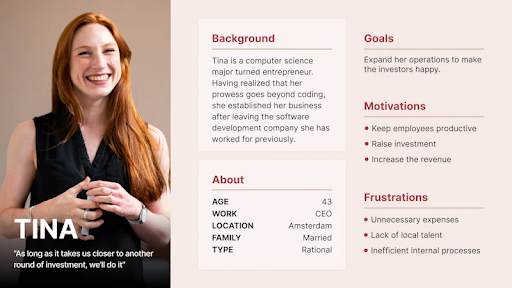
Empathy Maps: Visual representations of user experiences, capturing their thoughts, feelings, actions, and pain points.
Customer Journey Maps: Visualizations of the steps a user takes to achieve a goal, highlighting touchpoints and opportunities for improvement.
Problem Statements: Concise and clear statements that define the problem to be solved.
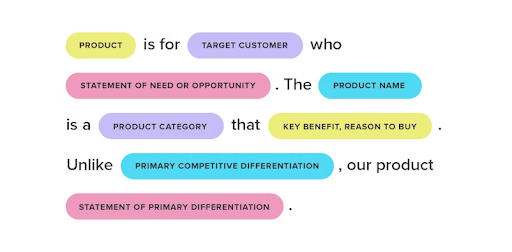
Solution Ideation Templates: Tools for brainstorming and generating creative solutions.
Recommended Design Thinking Tools
Templates aside, technology has made the whole design thinking procedure much easier. To apply design thinking at the enterprise level, there's a big need for a modern AI and design collaboration tool.
Miro: A versatile collaboration platform for whiteboarding, mind mapping, and diagramming.
Figma: A powerful design tool for prototyping and user interface design.
Mural: A visual collaboration tool for brainstorming, ideation, and problem-solving.
Sketch: A digital design toolkit for creating user interfaces.
Adobe XD: A UX/UI design tool for designing user experiences.
Using these tools and templates, you can enhance the efficiency and effectiveness of your EDT practices.
Challenges and Limitations of Enterprise Design Thinking
While Enterprise Design Thinking is a powerful framework, we cannot afford to overlook its potential challenges and limitations. Here's what to consider:
Resistance to Change: Introducing a new approach can face resistance from individuals or teams who are accustomed to traditional methodologies.
Time and Resource Constraints: Dedicated time and resources are necessary for effective EDT implementation.
Measuring Impact: Quantifying the impact of EDT can be challenging, especially in the short term.
Complexity of Large-Scale Projects: Scaling EDT to large-scale projects may require additional planning and coordination.
Fortunately, there are steps to mitigate some of these setbacks; organizations should:
Secure Executive Sponsorship: Obtain support from senior leadership to prioritize EDT.
Build a Strong Design Thinking Culture: Promote a culture of innovation, experimentation, and collaboration.
Provide Adequate Training and Support: Equip teams with the necessary skills and knowledge.
Start Small and Scale Gradually: Begin with smaller projects to gain experience and build momentum.
Measure and Iterate: Continuously evaluate the impact of EDT and make adjustments as needed.
Showcase Success Stories: Highlight the positive outcomes of EDT projects to build enthusiasm and support.
Collaborate with External Experts: Seek guidance from experienced design thinkers or consultants to accelerate the implementation process.
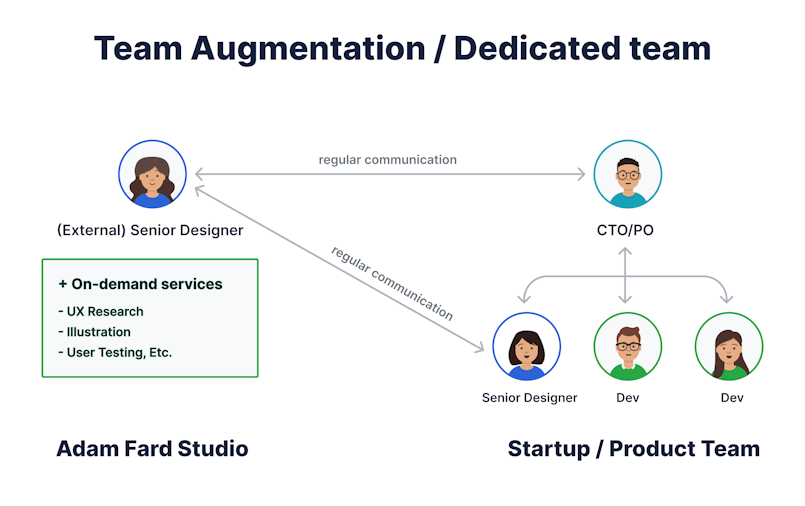
Need help with facilitating an efficient enterprise design thinking process? Book a free consultation with our experts today.
The Future of Work and Enterprise Design Thinking
The future of work is undergoing significant transformation, driven by technological advancements and changing societal needs. Remote work, hybrid models, and the rise of digital tools are reshaping how organizations operate and innovate. Enterprise Design Thinking (EDT) must adapt to these changes to remain relevant and effective.
The Impact of Remote Work and Hybrid Models on EDT Practices
Remote and hybrid work models have introduced new challenges and opportunities for EDT:
Virtual Collaboration: Effective virtual facilitation and collaboration tools are essential for remote teams to engage in design thinking activities.
Asynchronous Communication: Using tools like Slack, Microsoft Teams, or Asana to facilitate asynchronous communication and collaboration.
Remote User Research: Conducting virtual user interviews, surveys, and usability tests.
Digital Prototyping: Leveraging digital prototyping tools to create and test design concepts remotely.
Emerging Trends in Design Thinking
Design Justice: This approach focuses on addressing systemic inequalities and ensuring that design solutions benefit marginalized communities.
Inclusive Design: Designing products and services that are accessible and usable by people with diverse abilities and backgrounds.
AI-Powered Design: Utilizing AI tools to automate tasks, generate design ideas, and analyze user data.
Ethical Design: Considering the ethical implications of design decisions and prioritizing human well-being.
Organizations that want to ensure that their EDT practices remain relevant and impactful in the future must embrace these emerging trends.
The bottom line
Design Thinking is a marvelous framework for organizations of all sizes—it enables thoughtful collaboration, alignment, and user-centricity. However, larger organizations may find it more complicated to follow this framework due to a wide array of reasons ranging from the number of people involved in a project to the financial implications of failure. Enterprise Design Thinking provides ample opportunity for innovation and agility while mitigating the problems we mentioned above.

